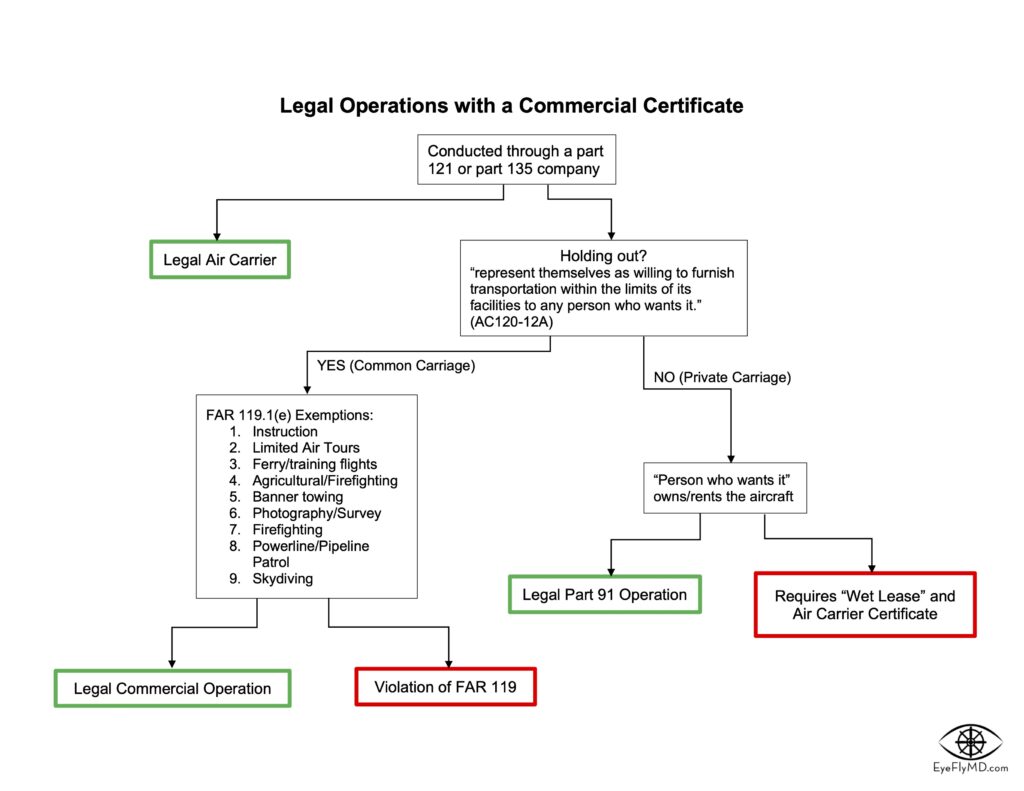Commercial Pilot Resources
Here is a document covering the requirements, general checkpoints, and endorsements necessary for a Commercial Pilot Certificate.
For more information, consult the relevant parts of the FAR/AIM:
§ 61.123 Eligibility requirements: General.
§ 61.125 Aeronautical knowledge.
§ 61.127 Flight proficiency.
§ 61.129 Aeronautical experience.
§ 61.133 Commercial pilot privileges and limitations.
Legal Operations with a Commercial Pilot Certificate
This is a complex topic and is likely to comprise a decent portion of the commercial checkride. You should be familiar with these terms and the flowchart can also help you make the right decisions on what is and isn’t legal.
It is also important to note that “compensation or hire” may seem vague but according to AC 61-142, the FAA considers flight time as “compensation.” Therefore, consider a private pilot flying their club’s aircraft to another airport with a maintenance shop and because it’s a “maintenance flight” the club waives the charges. This is technically compensation as the pilot is receiving flight time and would require a commercial certificate for this ferry operation.
Holding Out: When a carrier represents itself “to the public, or to a segment of the public, as willing to furnish
transportation within the limits of its facilities to any person who wants it.” (AC120-12A) Examples include advertising, signs, announcements, or reputation.
Air Carrier Certificate: Issued by the FAA to ensure the holder can design, document, implement, and audit safety critical processes that comply with regulations and safety standards, and manage hazard-related risks in operating environment in compliance with FAR Part 121 (airlines) or Part 135 (private charters).
Part 121: Regulations pertaining to the operation of scheduled air carriers (i.e., the airlines).
Part 135: Regulations pertaining to the operation of commuter and on-demand charters (e.g., private jets).
Part 125: Regulations pertaining to the operation of aircraft with > 20 seats or a maximum payload capacity of > 6,000 pounds, when used for private carriage (e.g., charter of large aircraft).
Common Carriage: “A carrier becomes a common carrier when it “holds itself out” to the public, or to a segment of the public.” (AC120-12)
Private Carriage: The transport of goods by a carrier who is under contract to transport those goods by vessel. (common law)
Dry lease: The owner provides the aircraft without a pilot or crew. Neither the owner or lessee needs an air carrier certificate if the aircraft doesn’t carry people or property for compensation or hire. The lessee usually assumes operational responsibility (e.g., maintenance, insurance).
Wet lease: The owner supplies the aircraft with a pilot or at least one crew member. The owner assumes operational responsibility (e.g., maintenance, insurance).
Leaseback: The owner sells the aircraft to the lender who then leases the aircraft back to the original owner.

Commercial Maneuvers
Chandelles
This WWI maneuver consists of a maximum performance climb while executing a 180° turn. Throughout the maneuver, the flight attitude is constantly changing.
Eights on Pylons
Eights on pylons are the most advanced ground reference maneuvers. Find the lesson plan and presentation below.
